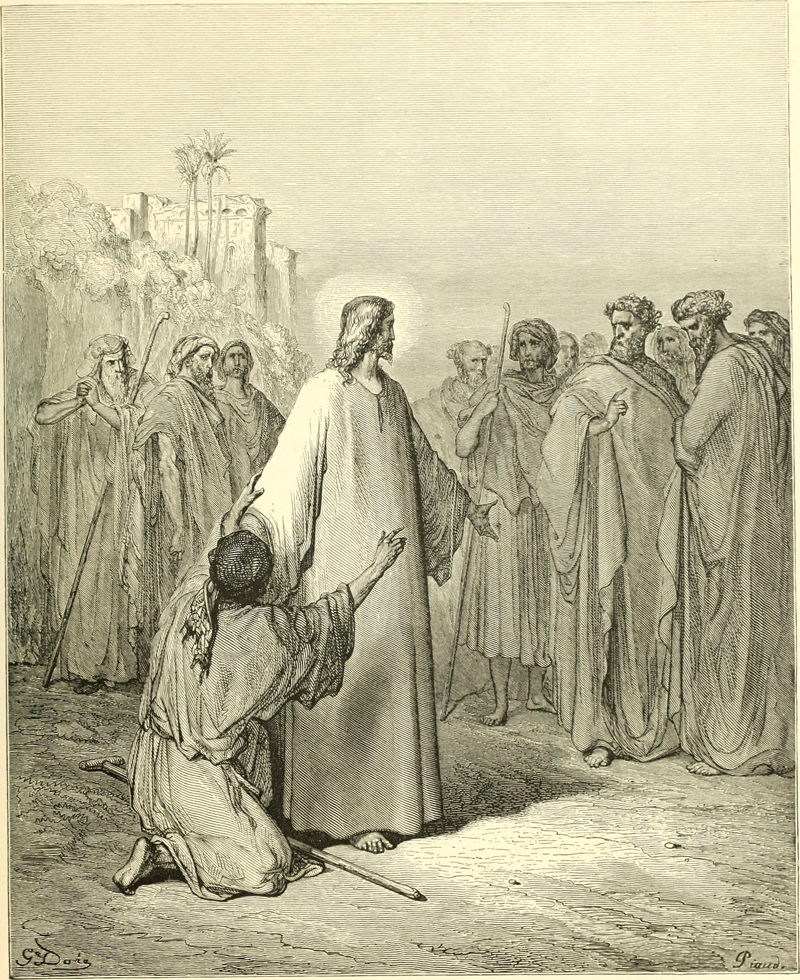
Jesus Cured The Leper
William A. Foster, 1891
My dear friends,
In Mark 1:40-45, we find a confluence where the Christian narrative of compassion aligns seamlessly with the Bodhisattva's path of altruistic intention and action.
and kneeling he said to him,
"If you choose, you can make me clean."
Moved with pity, Jesus stretched out his hand
and touched him, and said to him,
"I do choose. Be made clean!"
Immediately the leprosy left him,
and he was made clean.
- Mark 1:40-42
In the time of Jesus, lepers were marginalized and avoided due to their physical condition and the societal beliefs surrounding ritual purity. By choosing to touch the leper, Jesus not only physically heals the man but also symbolically breaks down the barriers of exclusion and stigma. This act goes beyond mere physical healing; it's a radical statement of inclusivity and compassion. Jesus treats the leper, a person shunned and avoided by society, with the same dignity and care as any other person. This aligns with the fourth verse of Geshe Langri Thangpa's Eight Verses of Training the Mind:
Or those overwhelmed by heavy misdeeds or suffering,
I will cherish them as something rare,
As though I’d found a priceless treasure.
Jesus' action teaches us to embrace those who are suffering, to not shy away from their pain or discomfort. Jesus shows us that such individuals are deserving of love, compassion, and human touch. They are not to be avoided but to be valued as precious, for in engaging with their suffering, we are offered a profound opportunity for practicing deep compassion and understanding the true nature of suffering and its alleviation.
"See that you say nothing to anyone; but go, show yourself to the priest,
and offer for your cleansing what Moses commanded, as a testimony to them."
- Mark 1:43-44
In instructing the healed man to be discreet, Jesus teaches humility and discretion, akin to the Bodhisattva's practice of selfless action without seeking personal glory. The focus is on the act of kindness itself, not on the accolades it might bring.
In the Jewish tradition of that time, healing from leprosy involved an intricate ritual conducted by priests, as prescribed in Leviticus 14. This ritual was not only a physical process but also a means of re-integrating the individual back into society, as leprosy carried a heavy social stigma and often resulted in exclusion and isolation.
By healing the leper with a simple act of compassion and then instructing him to show himself to the priest and follow the Mosaic law, Jesus is making a multifaceted statement. Firstly, He acknowledges and respects the existing religious law. By doing so, He ensures that the healed man can be officially recognized as clean by the religious authorities, facilitating his reintegration into society. Secondly, and more profoundly, Jesus' action demonstrates that the true power of healing lies not in the ritual itself but in the compassion and wisdom with which it is approached.
This act of Jesus is an invitation to look beyond the surface of rituals and religious practices and to connect with the deeper, universal truths they symbolize, particularly the transformative power of compassion and wisdom.
so that Jesus could no longer go into a town openly, but stayed out in the country;
and people came to him from every quarter.
- Mark 1:45
The spreading of Jesus' miracle despite his request for silence symbolizes the inherent spread of compassionate actions. In the Bodhisattva path, actions of compassion naturally radiate and impact others, much like the far-reaching influence of Jesus' deeds.
(with the Ten Oxherding Pictures)
Mark 1:40-45 not only illustrates Christ's compassion but also resonates with the Bodhisattva ideal of selfless service. It is a call for us to engage deeply in acts of kindness and compassion, serving others without attachment to self or expectation of recognition.